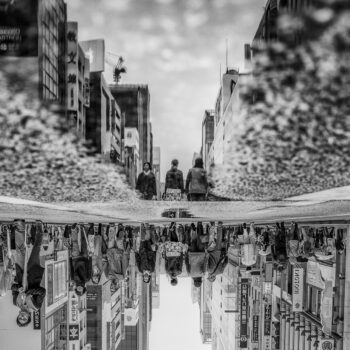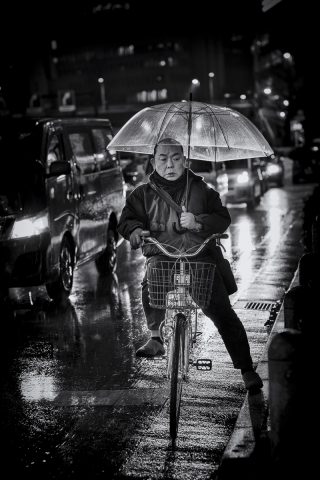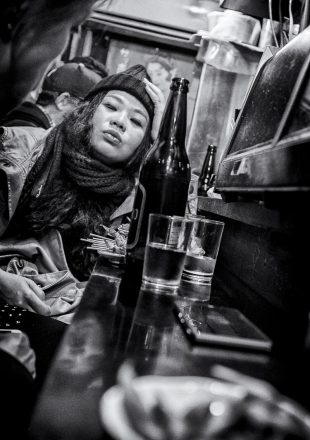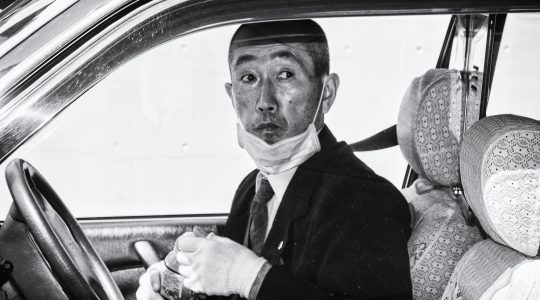Five minutes down the road from Old Street underground station, through the hustle and bustle of central London, I gazed through black and white windows to another world. Gerard Touren has been a photographer since he was 12 and shaped his own style of photography through his experience in advertising and his natural eye.
Gerard Touren’s photography exhibition at the Sway Gallery captured a curious, intimate and lonely everyday Tokyo. To a Londoner like me, the images were mixed with familiarity and otherworldliness.
Gerard Touren was present amongst the guests, happily chatting to them, excited about his first exhibition in the UK. When I asked, the worldly photographer was more than happy to answer a few questions about his mesmerizing journey through the heart of routine Tokyo, which was good, because my curiosity had been sparked.
What was your own life like in Japan at the time these pictures were taken?
Well, I landed with a group of photographers in Tokyo for an advertising project in March 2015. During that time, I visited the Magnum Agency to see a girl I knew and because of that, I met some more photographers. On the first day, I had trouble finding my hotel, so I walked through the streets for a long time, and finally, I stepped out in front of this guy on his bicycle and took a shot of him. That was the moment I said, “Wow, I’m in Tokyo! Why do I have to work right now!” *laughs*. So, I knew that when I finished the advertising project, I had to walk the streets again and take pictures, because it was so fascinating.
After spending ten days in Tokyo, I went back to Paris and looked through my photographs. I showed them to another photographer friend of mine, who said that I had to go back and take more. Since then I’ve been back three times. This exhibition is the result of probably four journeys to Tokyo.


Did you go to specific places for your Tokyo photography experiences each time, or were there always more new areas to see and explore?
Of all the places I discovered in Tokyo, there were three that interested me the most. Shinjuku, because it’s a very big station with a lot of trains and so many people. Every day a million people visit the station! It was intriguing because of all the movement – there was so much energy. The second one was Shibuya, which everybody knows. It had more young people, bars, fashion shops and things like that. The third was the Ueno market. Ueno market is a place with a lot of small shops and food places – everybody is walking. It’s not fashionable at all, but it still has so much energy. These were the three places I spent most of my time.
Curiously, it was difficult to get interesting shots of young people. Maybe it’s just in my case. I tried to capture them, but most of the time they were staring into their smartphones and when I took a picture they did this sign, *holds up two fingers and smiles*. For me, that’s not interesting.
I get that, too composed. I like the idea that young people are more prepared for a photograph than older generations.
It’s curious, because in other countries that were not the case. For example, in Belgium or Argentina, it was easy to get interesting pictures of young people. In Japan, I didn’t succeed. *Laughs*, maybe it was my fault.
What aspects of Japan were you trying to capture, in general, and in your Tokyo photography, and were they different from what you actually captured?
Well, as I told you, I didn’t go to Japan for street photography originally, I went for work. But in the end, Japanese people were so fantastic for me. I can’t get the same photographs in the streets of other countries, because Japanese people are different. We can’t understand each other; they don’t speak English and I don’t speak Japanese. They keep a distance, as well as being very organised and nice. So, if something is disturbing, they find it curious. If you don’t walk in the right part of the street, or if you stay in front of the door of the train, *laughs*, it’s very disturbing for them!
It was fascinating, I could come close to them and take my picture. They didn’t care about me and my camera, or whatever I was doing. Maybe they saw me as a tourist – they just didn’t care. But it was very pleasant that they didn’t care. The distance and the contact were new for me. It wasn’t the same thing as street photography in Italy or Belgium. When I work in those countries it’s hard to get so near to people, which is essential for me because I use a wide-angle lens. In Italy, that’s impossible to do.


And finally, why black and white?
It’s a long story. I began to take pictures when I was very young. My father had a camera and a dark room. So, using his own facilities, he taught me how to do prints myself. When I was a bit older, he gave me his darkroom material and camera, which I used for a long, long time. When I was a student, I spent my night printing black and white pictures in a dark room. Now it’s so inside me; I think I see a lot of things in black and white. These days I use digital cameras, which are colour rather than monochrome. Even so, I still convert the photographs to black and white in post-production.
Intrigued? Check out more Tokyo photography in Gerard Touren’s website. Also, The Sway Gallery have loads more exhibitions coming up.















































